Fast forward a few years: what might the venture ecosystem look like if AI-driven venture building becomes the norm? One compelling vision is that venture capital evolves from a financial industry into a platform-enabled industry utilising platforms like LettsGroup's AI VentureFactory . Further, instead of just funds competing to invest in startups, we could see integrated venture platforms that combine funding, tools, and talent in a single unified system. In effect, venture building could itself operate like a software platform – with startups as “users” who plug in to get everything they need to build a company.

LettsGroup hints at this future. It suggests a model where the process of venture creation and the provision of capital are fused in some way - something more akin to a venture factory that has attached capital pools . Entrepreneurs might engage with this platform not by pitching in a one-off transaction, but by entering into a program or ecosystem.
Imagine a platform where an entrepreneur with an idea signs up, and the platform (through AI) helps refine the idea, provides the initial funding as credit, supplies all necessary software infrastructure (perhaps cloud credits, AI tools, etc.), helps build the startup with AI outputs for each step in the venture building process, matches the entrepreneur with mentors or team members from a network, and basically shepherds the venture from inception to growth.
Such a platform might take some equity as a blended form of payment, some might even consider a revenue share. It’s like AWS + Y Combinator + an AI advisor/team + a VC fund all rolled into one, available on-demand. This could drastically lower barriers to entry globally, as access to venture building expertise and capital would no longer be limited by personal networks or geography – anyone plugged into the platform could benefit.
From the perspective of venture capital firms, those that successfully transform to utilising platforms like LettsGroup's AI VentureFactory (which has just added a new 'Investor Dashboard') will likely have a competitive edge. For example, a founder might prefer to work with a firm that offers a proven venture-building platform with, say, a 2x higher success rate, over more traditional VC style approaches that just give money but no support. This could lead to a consolidation where a few top venture platforms attract the best founders, akin to how a few cloud computing platforms dominate their space. It’s possible we see the rise of a “Startup Operating System” provided by a private company (or consortium) that many startups use, analogous to how many businesses use cloud services today.

Another aspect of the future could be contract venture building for others . LettsGroup speculated that mature venture factories could become contract manufacturers for venture ideas from large corporations or funds, similar to Foxconn building products for Apple. Taking that further, venture capital itself could outsource some of its venture creation to such contract venture factories. For instance, a pension fund that wants exposure to tech startups could simply commission a venture factory to build and scale a set number of companies in certain domains, rather than picking existing startups to invest in. This flips the venture model: instead of investing in entrepreneurs who come to you, you as an investor decide what you want (perhaps via market analysis) and then build it with the help of a venture platform. This approach might especially appeal to corporate venture arms or large pools of capital seeking predictable innovation for their needs. It’s somewhat analogous to how the semiconductor industry evolved – initially, integrated companies did everything, but later you had fabless companies that design chips and contract foundries that manufacture them. We could see “fabless” VCs (who have ideas and capital) and “foundry” venture factories (who build the ventures).
Such a platform-driven ecosystem could also globalise venture building beyond the major hubs like Silicon Valley. If the platform is accessible anywhere, talent from around the world could create startups using it, tapping local knowledge with global support. This might unlock innovation in regions that historically lacked access to venture expertise or capital. We might see specialised venture platforms focusing on different regions or sectors, all connected in networks.
The role of people in AI venture building platforms will also evolve. We will still need visionary entrepreneurs – AI can assist, but it doesn’t replace human creativity and leadership (at least not for the foreseeable future). We will also need experienced mentors and industry experts to guide startups (though AI might handle a chunk of the advice, human judgement remains key for nuanced decisions). However, these people might be engaged in a more flexible way. The LettsGroup model mentions an “expanding network of experienced venture leaders who each contribute to multiple ventures” in their ecosystem. This hints at a gig-economy or fractional involvement model: an expert could be overseeing strategy for 3 ventures at once via the platform tools, something that’s feasible if those ventures run systematically. The platform orchestrates contributions so that expertise is shared efficiently. This collective model leverages scarce talent (like seasoned startup execs) across many companies without each startup needing to hire them full-time.
The power dynamics in such a future platform-centric ecosystem likely shifts more in favour of founders (or founding teams) and the platform operators, and a bit away from traditional VCs. If entrepreneurs have direct access to what they need, the competitive advantage of having venture connections declines. However, platform operators (which might be evolved VC firms or new entities) become extremely influential. They might even fund companies off their own balance sheet or via new mechanisms like tokens if blockchain is involved.
We may also see blurring of public and private markets . If venture creation becomes more repeatable, investors like private equity or even public market investors might want in at earlier stages through these platforms. Conversely, some startups might never need to go public if they achieve profitability quickly with a lean model – or they might get acquired by the platform itself if it makes sense.
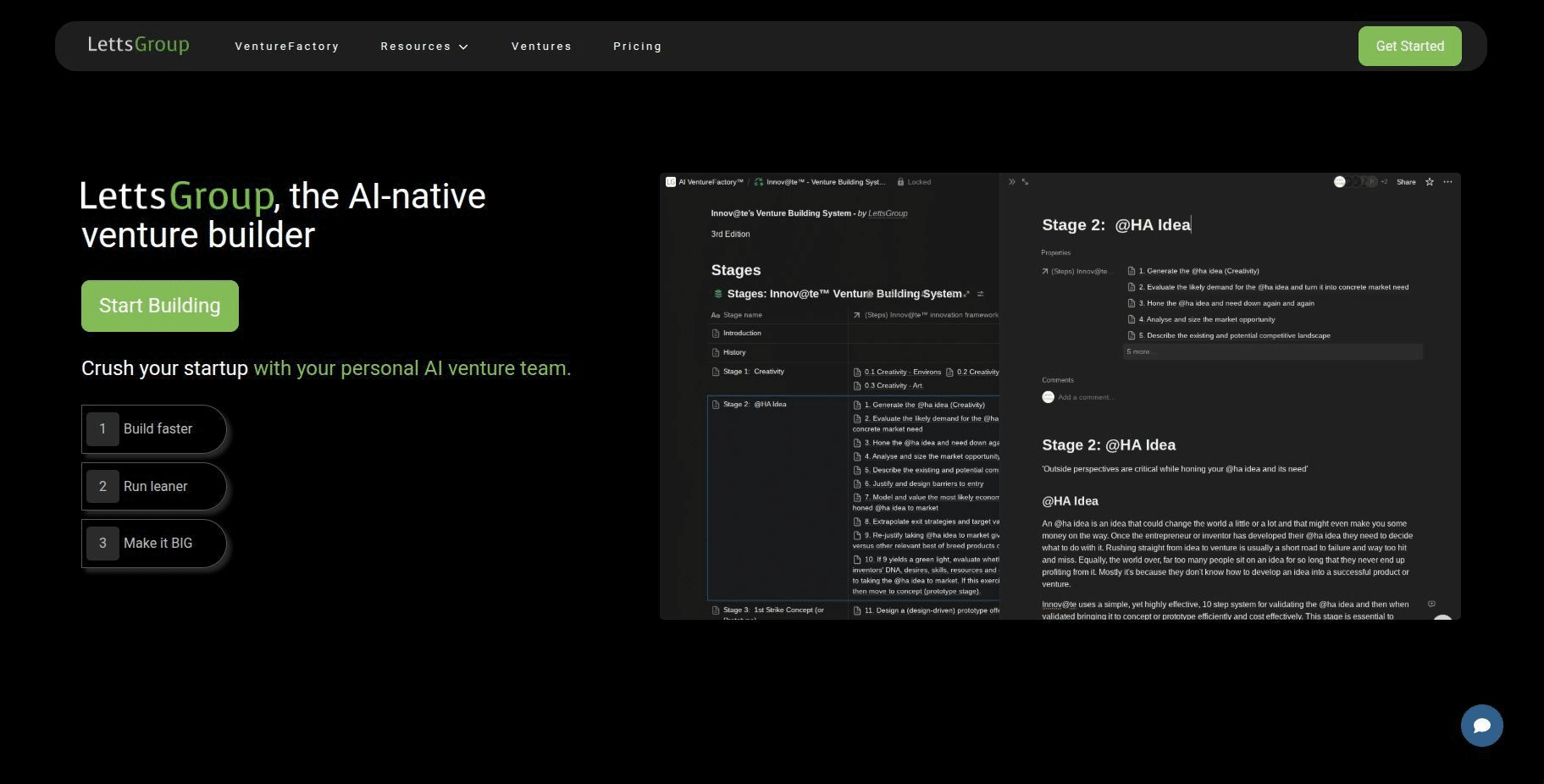
From the founder’s perspective, the future might involve choosing which venture platform to join similar to how one chooses which accelerator or incubator to join today – but with bigger consequences. Joining a platform could commit you to certain approaches (which can be good if they work). It might also come with standardised terms (maybe less negotiation of custom equity deals since platform deals could be cookie-cutter). Ideally, if multiple platforms exist, competition among them will keep terms fair and service quality high.
It’s also plausible that big tech companies become part of this story. For instance, Amazon or Microsoft could partner with leading venture building platforms to enhance their startup programs to embrace more full-fledged venture platforms (they already give cloud credits and some support; they could in theory expand into providing funding and offering systematic guidance via LettsGroup's AI VentureFactory for example, especially if it drives usage of their ecosystem).
On the flip side, there are risks and challenges in this future. Will such heavy systematisation limit creativity? It’s important that venture platforms don’t become overly formulaic, lest they churn out cookie-cutter companies that lack true innovation. Platforms must allow flexibility and pivots – presumably the AI will learn to incorporate creative divergences when needed. LettsGroup talks about the critical; importance of AI-driven infrastructure and operations to free up time for creativity and enhance success.
Another challenge is mentorship and intuition – can AI fully replicate the mentorship a human VC or experienced entrepreneur provides? Likely not 100%, but it can augment it. The human element will remain, but possibly scaled via AI (e.g., one great mentor can impart knowledge via an AI that many startups benefit from).
In summary, the future of venture building as a platform could mean:
Ultimately, these changes aim to do what technology and process improvements always do: increase efficiency and output. In this case, the output is successful ventures, and efficiency means using less capital and time to get there. If pioneering firms like LettsGroup and Steel Perlot are indicators, we are moving toward a world where creating a startup is not a shot in the dark but a guided endeavour. Tomorrow's entrepreneur might say “I built my company on Platform X,” much like today one might say “I built my app on AWS.” And tomorrow’s investor might be as much a venture building platform user or partner as a stock picker.
As LettsGroup’s analysis puts it, this would be a fundamental restructuring of the power dynamics – shifting more control and value to innovative founders and the platforms that enable them, rather than traditional capital gatekeepers. The hope is that this democratises innovation and reduces wasted potential (all those failed startups that could have succeeded with better support). In the ideal future, venture building becomes accessible, data-driven, and successful on a scale never before seen – a true global innovation factory.
The next section of our guide to New Style Venture Building is 'Final Thoughts & Takeaways' - coming soon.
If you're a tech or digital startup founder, build faster, run leaner and make it BIG with LettsGroup's AI VentureFactory .
As startups grow, their leadership needs often evolve. Early on, what a company needs from its leaders (usually the founders) is very different from what it needs once it has hundreds of employees or steady, predictable revenue. These two phases require distinct mindsets, often referred to as “Founder Mode” versus “Manager Mode.” In the context of AI-driven, automation-first startups, understanding these modes – and knowing when to shift gears – is crucial. The injection of AI and efficient processes can actually extend the runway of Founder Mode, but eventually elements of Manager Mode must come in for stability. Let’s break down these leadership modes and how they apply in modern venture building.

Founder Mode is characterised by scrappiness, creativity, and an embrace of chaos. In Founder Mode, leaders are like inventors and explorers. They thrive with incomplete information and urgent deadlines, willing to make quick decisions and big bets. They wear many hats – one minute coding or designing, the next minute pitching to a customer or fixing a broken process. Paul Graham of Y Combinator likens it to an obsessive focus on building and iterating quickly, almost like living in a constant hackathon. Brian Chesky of Airbnb exemplified this with his relentless focus on perfecting the product experience in the early days – a very hands-on, detail-oriented approach driven by passion.
Common traits of Founder Mode leaders include:

Manager Mode , on the other hand, is characterised by establishing structure, repeatable processes, and efficiency. A Manager Mode leader is akin to a corporate executive: focused on optimising, organising, and minimising risk. This is ideal once a company has found a formula that works and needs to scale it reliably or maintain it. In Manager Mode, you create departments, define roles clearly, implement policies, and rely on data and procedures to drive incremental improvement.
Traits of Manager Mode leaders include:
Both modes are important, but timing is everything. In a high-growth startup early on, too much Manager Mode can be deadly. If you install a rigid manager when the company still needs to be pivoting and experimenting, you can smother the innovation. As one commentary noted, bringing a corporate manager into a startup too soon is like “asking a librarian to DJ at a rave” – a mismatch that can end in disaster for both parties. Corporate managers might impose 12-step approval processes and demand extensive data for every decision, which just doesn’t work when a startup needs to move fast and iterate with limited info. For example, a manager might say “we can’t launch this feature until it passes all these internal reviews,” whereas a founder mode approach might be “let’s get a prototype in front of users next week and see what happens.” In early stages, speed and agility beat perfection and procedure. Overemphasis on Manager Mode early can indeed suffocate the startup’s spirit – “innovation suffocation” as it’s been called – because startups thrive on creative chaos and risk-taking to find what works.
Conversely, in a mature company, pure Founder Mode can become problematic. If a company has hundreds of employees and significant revenue, you can’t have everyone constantly pivoting or ignoring process – it would be mayhem. A founder who continues to micromanage every detail and bypass all structure at scale can cause confusion, burnout, and strategic whiplash. At some stage, process and structure are necessary to not “crash the plane.” As one quip goes, you don’t want the accounting books to look like a teenager’s messy bedroom – eventually, someone has to bring order.
The tricky part for startups is navigating the transition or balance between these modes . Ideally, a startup uses Founder Mode in the beginning to find its footing, and gradually incorporates Manager Mode elements as it scales. But the leaders must be self-aware enough to either adapt or bring in help at the right time. Many founders are great at the early stage but either struggle or lose interest in running a later-stage organisation. On the other hand, bringing in “adult supervision” (manager CEOs) too early can kill the company. So there’s a timing dance.
In AI-driven startups, this dynamic has some interesting twists:

A good strategy is for founders to surround themselves with complementary leadership as the company grows. That could mean hiring a COO or other executives who bring Manager Mode skills while the founder remains the visionary. However, it’s critical that those hires understand startup culture and don’t enforce big-company rules prematurely. LettsGroup humorously describes what goes wrong when you drop a corporate manager into a startup: they build a “corporate cage” for a company of five, they turn the culture from “move fast and break things” to “move cautiously and file a report about it,” and they take so long analysing risk that competitors outpace the company. To avoid this, any managers brought in must adapt to a startup’s needs – perhaps a “Manager Mode 2.0” that is informed by entrepreneurial thinking.
Likewise, founders must eventually embrace some managerial responsibilities. A wise founder will gradually institute necessary process in areas like finance (you can’t ignore accounting forever), HR (especially as you hire more people, you need policies for fairness and legal reasons), and product QA (as users scale, quality issues become more serious). The key is doing it pragmatically: implementing just enough structure to solve current pains, but not so much to constrain innovation. LettsGroup noted, for instance, that Manager Mode absolutely has its place once a startup hits a more stable, mature phase – no founder actually wants zero processes when they have, say, 100 employees; at that point, chaos can do real damage. It’s about the right dosage at the right time.
In founder-friendly venture building environments (like the venture factory), there is recognition that the founder’s original qualities – passion, drive, willingness to fail fast – are precious and should be preserved as long as possible. So rather than replacing founders, the aim is to coach them and supplement them . For example, a venture factory might provide leadership training or mentors to help a founder develop managerial skills when needed, or conversely, teach a corporate-type co-founder how to stay flexible and innovative. LettsGroup’s research into key traits of successful founders vs. managers and how they interconnect suggests that awareness of these differences is itself valuable. A startup team that understands who is playing founder vs manager roles, and respects each other’s contributions, can achieve a healthy balance.
In an AI-automated startup, some traditional managerial tasks (like status reporting, task assignment) might be handled by the system, leaving managers to focus more on coaching, culture, and decision-making . In that sense, Manager Mode might shift from micromanaging process to setting high-level guardrails and maintaining efficiency. The motto could be “don’t suppress the chaos entirely, just channel it constructively.” As one analysis put it, in early stages you need a “chaos pilot, not a process prophet”. Over time, you slowly introduce more process prophets in supporting roles once the rocket is already flying.
To put it succinctly, Founder Mode is for search, Manager Mode is for execution. A startup begins in search mode – searching for product-market fit, a viable model. Once found, it transitions to execution mode – scaling that model. Founder Mode leadership excels at search; Manager Mode excels at execution. The tricky part is that scaling isn’t a binary switch; it’s a gradient. So there’s a period where both mindsets are needed: the company is executing what’s working and still searching in other areas (new features, new markets). During that period, having a leadership team that covers both bases is ideal – perhaps the CEO remains very founder-like, while a COO or VP Operations is more manager-like, and they work in tandem.
In conclusion, startups should cherish Founder Mode in the beginning – it’s where the bold vision and rapid progress come from – and avoid premature bureaucratisation. As they grow, they should carefully weave in Manager Mode elements – often through processes, tools, or selected hires – to ensure stability and efficiency. The most successful companies often have founders who evolved into effective large-scale leaders (think Bill Gates, who started as a hardcore coder and eventually managed a giant company, or Mark Zuckerberg who had to balance move-fast culture with running a global corporation). Not every founder will become a great late-stage CEO, but those who do often drive exceptional outcomes. For those who don’t, the best scenario is that they partner with or yield to someone who can manage without killing the founder spirit of the company.
As the LettsGroup piece humorously concludes: neither Founder Mode nor Manager Mode is inherently superior – they’re just “catastrophically wrong when misapplied”. The art of leadership in an AI-driven startup is to apply the right mode at the right time. With AI and venture platforms smoothing some transitions, founders may be able to lead further and more effectively than in the past, supported by systems that compensate for their managerial weaknesses. And when the time comes to hand over to more Manager Mode leadership, it should be done in a way that doesn’t lose the innovation DNA of the startup. Remember, you “can’t cat-proof a Frisbee” – you can’t make an inherently risky, revolutionary venture completely risk-free or it would lose its essence. The goal is to manage the risks, not eliminate them. Founder Mode provides the courage to take risks; Manager Mode provides the prudence to mitigate them. Balancing the two is who dares, wins.
The next section of our guide to 'New Style Venture Building' is 'Case Studies of AI-Driven Ventures' - coming soon.
If you're a tech or digital startup founder, build faster and run leaner with LettsGroup's AI VentureFactory .
If startups can do more with less capital thanks to AI and automation, what does this mean for the venture capital (VC) industry that funds them? The implications are profound. Traditionally, venture capital’s role has been to provide the significant funding needed for startups to scale (hiring, marketing, etc.) in exchange for equity. But in an environment where a startup might only need a few hundred thousand dollars – or no outside capital at all – to reach profitability or substantial revenue, the value proposition of traditional VC is challenged .
In an AI-enabled venture ecosystem, human and intellectual capital trump pure financial capital . That is, the best ideas and teams might not need as much money, but they might need other support (like AI resources, infrastructure, or networks). Venture capital firms, therefore, may have to evolve from being primarily money suppliers to being true value-add partners. Already, a few VCs try to differentiate by offering “platform” services (like recruiting help, PR, or strategic advice). But the new style venture building suggests a shift beyond that: VCs might need to white-label or even build actual venture-building platforms and AI tools to the startups that they back.

One likely outcome is the rise of “operational venture capital” models and venture studios run by investors . We have seen early steps of this with firms like a16z (Andreessen Horowitz) building large internal teams to help startups, or Project A in Europe which has functional experts on staff to deploy to portfolio companies. LettsGroup itself positions as a “new category of venture builder” that builds and sometimes even backs ventures through their AI VentureFactory, aiming for systematically better outcomes . And LettsGroup's new VentureFactory dashboard for VCs enables them to come to the table not just with a check, but with a platform like its AI VentureFactory that the startup can plug into for instant scale capability. Essentially, the VC firm itself could act more like a venture factory or incubator for its portfolio.
Another implication is on the financial side: smaller rounds and potentially leaner valuations in early stages. If a startup can get further on its own or with less money, it may delay raising or raise less. This could mean fewer equity dilutions for founders and a harder time for VCs to deploy large funds. Some VCs might respond by focusing on quality over quantity and earlier stage deals – investing in more startups with smaller tickets, hoping that higher success rates (even if exits are smaller on average) will yield good returns. The old model of needing a few unicorns to pay for all the duds might shift if there simply are fewer duds (because venture building is more predictable). In such a scenario, VC portfolio strategy could become a bit more like private equity – targeting solid businesses and helping them grow efficiently – rather than a high-risk lottery.
However, one could also argue that easier scalability will create bigger successes too, not just moderate ones. A startup that grows super efficiently might capture markets faster and end up a huge win with minimal capital. That’s great for founders, but for VCs it raises the question: how to ensure you’re part of that journey if your money wasn’t needed early on? This is where disintermediation risk comes in. If founders don’t need as much VC money, they might skip it or use alternative financing (like revenue-based financing, crowdsourcing, corporate investors, or grants). Moreover, AI itself could connect founders directly with capital sources. One analysis predicts that AI agents will link entrepreneurs to investors directly, potentially bypassing traditional VC firms . We can imagine AI-driven platforms (perhaps blockchain-based or marketplaces) where startups get matched with interested investors (angel, family office, etc.) without going through the classic VC gatekeepers. If that becomes common, the power of big VC funds could diminish, unless they partake in those platforms.

VCs are aware of these shifts. In fact, some forward-looking venture firms are already experimenting with automation internally – for example, using AI to screen business plans or perform due diligence faster. But those are incremental improvements to their operations. The larger disruption is if the venture firms themselves must change their model . The LettsGroup vision hints that “the venture capital firm of tomorrow will function as an AI system with an associated network of entrepreneurs.” In practice, this could look like a VC that has built or white-labelled its own AI venture factory (like a LettsGroup for external ventures) where it can spin up companies almost on demand, assigning great entrepreneurs to lead them, with all the back-end provided. Such a firm might not evaluate deals in the traditional sense; rather, it co-creates ventures, providing both the idea or platform and the funding. This blurs the line between investor and builder. It’s almost a venture builder-VC hybrid .
Another scenario is venture capital as a platform service that external startups subscribe to. LettsGroup literally states they are on a mission to build and enable “venture capital-as-a-platform”. They have kicked this off by providing their VentureFactory platform to other investors and corporate incubators or investors. In the future, a startup might pay for access to a VC’s platform (including capital, but also tools and guidance) rather than just taking a check. The VC would monetize not only through equity but possibly through subscription or profit-sharing models. This changes the revenue model of venture investing from purely equity returns to a mix of equity and service revenue. It could also democratise access – a startup that doesn’t get a term sheet might still be able to pay to use the VC’s platform/tools to improve and eventually earn investment.
For traditional venture capitalists, these changes pose a challenge: how do you stay relevant when capital is commoditised? The likely answer is they must move up the value chain – offer things that money alone can’t. This might include:
We might also see a shift in power towards founders . If one of the aims of AI venture building is to empower entrepreneurs (and indeed some argue the AI-enabled future should “ultimately empower entrepreneurs more effectively than simply enriching venture capitalists”), then founders with good track records or strong ideas will have more options. They could choose to go it alone longer, or demand better terms from investors. The balance of negotiation could tilt slightly towards founders who have an AI-boosted operation and are less desperate for cash. This might result in friendlier deal terms, less onerous preferences, etc., as VCs compete to get into good deals. We’re already seeing super large funds and many new funds chasing a finite set of great startups; if those startups need less funding, the dynamic intensifies.
Interestingly, some new venture entities like Steel Perlot (backed by Eric Schmidt) are positioning themselves in line with these trends. Steel Perlot aims to “identify, invest in, and develop multi-generational platforms” and sometimes builds companies directly, only supporting those they think can reach global scale. This is a more interventionist model of venture investing , focusing on systemic change in target industries and blending capital with deep involvement. It aligns with the idea that VCs will pick specific domains to specialise in with technology (Steel Perlot presumably leverages AI expertise from its backers) and ensure their ventures in those domains benefit from that infrastructure.
We also see corporates entering the venture building space (corporate venture studios or incubators) which could become competitors or partners to VCs in funding innovation. If corporations build new companies internally using venture factory methods (like Mach49’s work with large firms), they might spin them out or fund them in ways that bypass traditional VC rounds. VCs might then find fewer high-quality independent startups, as some are birthed and grown inside corporate ecosystems or by venture platforms.
To adapt, venture capital might look more like “innovation capital” integrated with incubation . For example, a fund might say: “We invest $500k and also enroll you in a venture building platform which will handle X, Y, Z for your company.” The success metric might shift from just financial returns to also the success rate of portfolio (bragging about how 60-70% of their startups hit profitability, for example, rather than 90% failing). If investors can claim that their involvement doubles a startup’s chance of success, that’s a powerful selling point to founders deciding whose term sheet to accept.
There’s also the possibility that VC as we know it fragments into new forms:

Finally, the economics for VCs might shift. If startups require less money overall, funds might either shrink in size or find new ways to deploy capital (maybe investing in more startups or returning money to LPs sooner). The high management fees of mega-funds might be harder to justify if one can’t invest that money well due to more efficient startups. Conversely, if venture factories dramatically increase the number of viable startups, there could actually be more companies to invest in (just each needs less), potentially broadening the market for early-stage investing.
In summary, the implications for venture capital include:
As one Letts Journal article concluded, “tomorrow’s entrepreneurs may integrate with venture factory platforms rather than traditional legal structures that offer limited value beyond capital” , shifting greater control and value creation to founders and innovative builders. Venture capital firms, to remain central, will likely transform into these very platforms or align with them. We are likely to witness a convergence of roles: investors becoming builders and builders becoming investors – all facilitated by AI and systematic processes. The venture capital industry has always been about taking calculated risks on innovation; now it may have to innovate its own model to keep up with the entrepreneurs who increasingly can flourish without it.
The next section of our guide to New Style Venture Building is 'Founder Mode vs. Manager Mode Leadership' - coming soon.
If you are a founder or investor, sign up to LettsGroup's AI VentureFactory today.

The Trump era has never been only about Trump. It has always been about ideas, about who gets to define America’s past, present, and future. As Joshua Chaffin and Zusha Elinson reported in The Wall Street Journal (“The Ideological Gurus Battling for the Soul of Trump World,” May 9, 2025), the movement’s intellectual landscape is shaped by an unruly mix: nationalist-populists, libertarians, Catholic postliberals, and even the online counterculture that thrives on memes and irony.
At the heart of this ferment stands Patrick Deneen, the University of Notre Dame political theorist whose book Why Liberalism Failed (Yale University Press, 2018) jolted the academic and policy world. His argument was stark: liberalism has not been betrayed but pushed to its logical end. Its relentless focus on individual freedom and market forces, he argued, has eaten away at the communal bonds and civic trust on which societies depend.
Deneen’s follow-up, Regime Change: Toward a Postliberal Future (Penguin Random House, 2023), moved from diagnosis to prescription. He called for an “aristopopulist” alliance to replace today’s liberal elite with a new class guided by the common good and civic renewal. The aim, he wrote, was not violent overthrow but something “far more revolutionary”: a deep reorientation of institutions.
That phrase was picked up by Ian Ward in POLITICO (“‘I Don’t Want to Violently Overthrow the Government. I Want Something Far More Revolutionary,’” June 2023), where he framed it as the rallying cry of a growing insurgency. The core claim was that legitimacy cannot be restored by patching up the old liberal order, it requires a new one.
And in his 2025 essay for UnHerd (“Why the MAGA-DOGE coalition will hold,” March 2025), Deneen extended the argument into electoral politics. The “MAGA” base and the libertarian-inflected “DOGE” digital right, he suggested, form a coalition of unlikely allies bound mainly by shared opposition to establishment liberalism.
Patrick Deneen is a political theorist at the University of Notre Dame whose work has become a touchstone for America’s postliberal right. His 2018 book Why Liberalism Failed argued that liberalism doesn’t collapse from betrayal but from success, its emphasis on autonomy and markets eventually hollows out the civic trust that sustains society.
That argument struck a nerve in both academia and politics. Former President Barack Obama even recommended the book, calling it a serious challenge to liberal assumptions. But Deneen’s ideas have travelled farthest on the populist right, shaping the thinking of figures like Vice President J.D. Vance.
Vance has echoed Deneen’s themes of elite failure and the need for rooted communities. As The Wall Street Journal reported in May 2025, Deneen is one of several intellectuals whose critiques of liberalism now influence the ideological battles inside Trump World.
For supporters, Deneen offers a roadmap for civic renewal. For critics, his prescriptions risk sliding into illiberalism. Either way, his reach shows how arguments once confined to political theory seminars are now shaping debates in Washington.

In his UnHerd essay, Deneen argued that two unlikely camps have fused into a durable political alliance.
MAGA stands for Donald Trump’s populist base: culturally conservative, working-class voters hostile to elites and traditional institutions.
DOGE is shorthand for a digital counterculture shaped by libertarian tech circles, meme culture, and online subversion.
On paper, these groups seem incompatible. MAGA distrusts globalism and craves rooted community, while DOGE thrives on internet freedom and mockery of authority. Yet, Deneen contends, both share a deep resentment of establishment liberalism and a desire to upend the current order.
The coalition is less about policy than mood: populist anger meets digital disruption. In Deneen’s telling, it explains why Trump’s appeal endures and why the intellectual debates of “Trump World” now matter far beyond campaign rallies.
What does any of this have to do with the media industry? Quite a lot. Deneen’s critique of liberalism lands uncomfortably close to journalism’s own crisis.
For decades, the news business relied on a liberal consensus: objectivity, gatekeeping, a shared public square. That consensus has frayed. Legacy outlets no longer monopolise authority. News consumption has splintered into podcasts, Substacks, TikToks, and Twitter threads. AI now floods the infosphere with automated articles, synthetic audio, and hyper-targeted propaganda.
The result is a public mood that mirrors what Deneen sees in politics: exhaustion. “News ennui” is journalism’s version of postliberal malaise. Consumers are drowning in content, sceptical of institutions, yet still hungry for coherence.
In Why Liberalism Failed, Deneen argued that liberalism eventually dissolves its own foundations. By maximising freedom, it erodes the authority structures that make order possible. Journalism faces a similar paradox: in chasing reach, speed, and endless choice, it has undermined the trust that once made it viable.
The problem today is not scarcity of information but glut. In an AI-saturated ecosystem, stories no longer compete on accuracy but on virality. Deepfakes, spin, and algorithmic news blur truth and fiction. And just as postliberals argue that politics requires a new civic anchor, journalism must find its own ballast.
For independent journalists, the challenge is acute. They cannot outproduce AI, nor outspend platforms. What they can offer, if they adapt, is the kind of rooted authority Deneen thinks politics itself needs.
That starts with telling stories that cut through the noise. AI can churn out summaries and surface-level content, but it cannot give readers the grounding that makes a story matter. Deneen’s influence comes not from daily commentary but from showing how today’s politics connects to older arguments. Journalists can do the same by offering context and meaning, not just headlines.
It also means thinking in terms of community rather than audience. Deneen’s postliberal vision stresses local ties and civic bonds, and journalism can take a similar lesson. Chasing clicks from strangers matters less than building loyal relationships with readers who trust your work. Membership-driven models, collaborative reporting, and slow journalism all point in that direction.
And finally, it’s about helping readers make sense of the flood. In a world drowning in content, people don’t need more information, they need guides. Independent journalists who can filter, frame, and explain the chaos will become indispensable, not as gatekeepers but as trusted navigators.
There is a clear symmetry here. Postliberal politics seeks to move beyond the exhausted liberal consensus. Journalism may need its own “postliberal turn”: a shift from the myth of detached objectivity toward rootedness, accountability, and narrative coherence.
This doesn’t mean partisan capture or ideological conformity. It means accepting that journalism, like politics, cannot float free of community and purpose. Without that grounding, audiences will continue to drift, to influencers, to conspiracy entrepreneurs, to AI hallucinations.
Deneen’s ideas remain contested. Critics accuse him of romanticising tradition, of underestimating liberalism’s resilience, of providing cover for illiberal populism. Yet his influence is undeniable: he has given shape to a mood of disenchantment.
Journalism faces the same mood. If audiences are tired of politics-as-usual, they are equally tired of news-as-usual. Independent journalists who ignore this risk are fading into irrelevance. Those who lean into it, who build trust, coherence, and community, may yet find themselves indispensable in an age of informational collapse.
Politics and media are living through parallel crises of legitimacy. Both must grapple with the exhaustion of liberal assumptions. Both must imagine new forms of authority without sliding into authoritarianism.
Rather than asking whether the old order has failed, Deneen argues that liberalism has already run its course. The real question, in his view, is what comes next. For journalists, that means asking whether they can be more than content providers. Can they become civic anchors in an atomised age?
If the answer is yes, then journalism’s regime change may not mark its end but its renewal.
Independent journalists are shaping the future of news in this turbulent media landscape. At LettsNews our AI-powered newsroom is built to give you the support you need to meet these challenges and thrive. Sign up for free at LettsNews today.
LettsGroup's AI VentureFactory is bringing a new startup each month to its AI-native venture building platform just 3 months after soft launching to external startups. Companies using it are seeing rapid gains in the 3 core KPI's it delivers - building faster, running leaner and making it bigger. The team is currently working on enhancements to its helpbot, venture building AI and native apps. Its core apps, 3rd party agents and step by step venture building AI outputs are proving to be a powerful new way to build and operate startups, and its new Investor Dashboard provides a fascinating mirrored 'pit' view into portfolio companies and prospects.
On 13 November 4pm-7pm LettsGroup will be co-hosting "LettsTalk Tech" with Brown Rudnick in central London for select tech investors and entrepreneurs. If you know one of the LettsGroup team, please contact them directly for an invite.
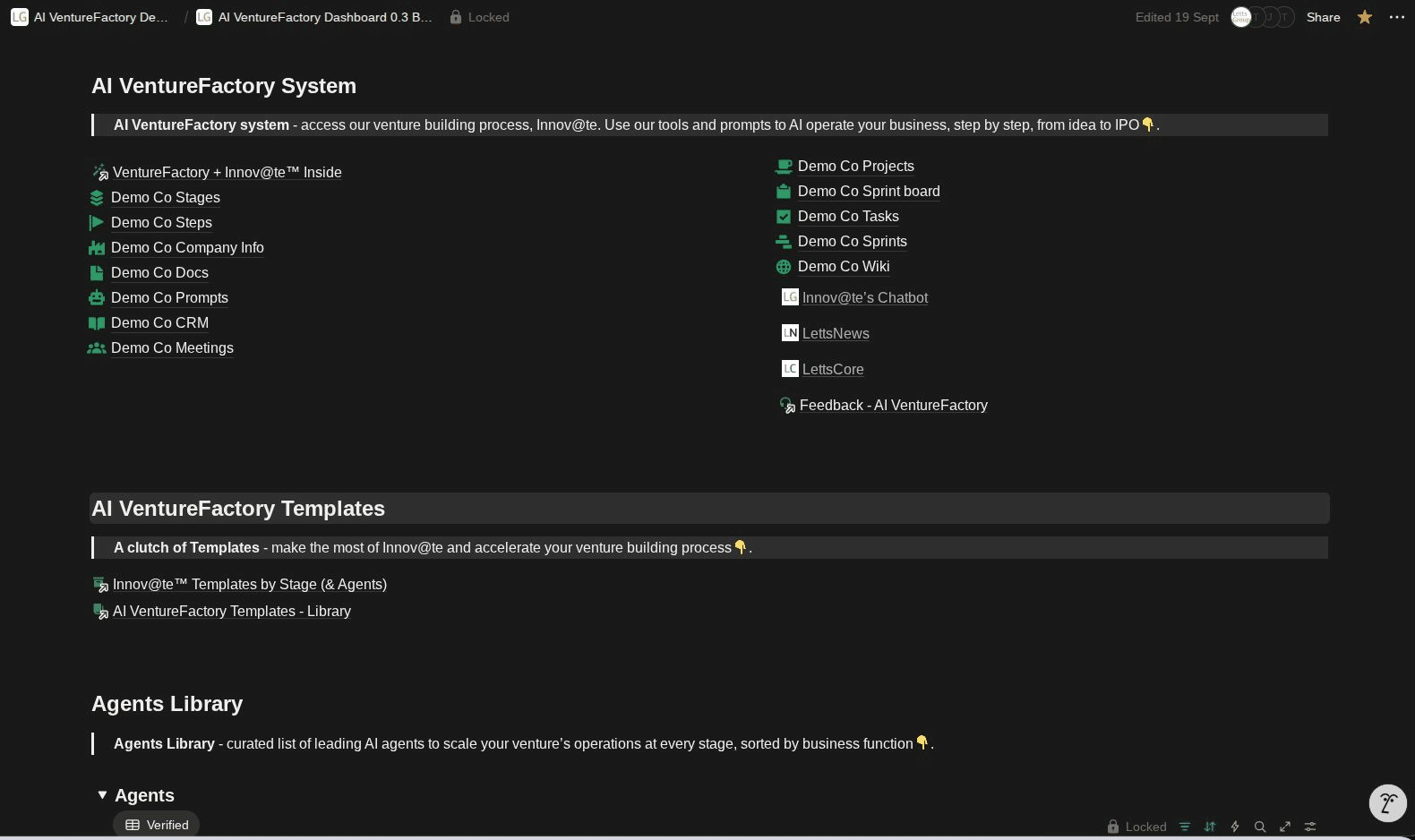
LettsCore , the Blockchain, AI CMS is live in beta and scaling quickly just a month after launching. With its first corporate customer (an AI app vendor) up and running it already boasts over 1,500 users, adding a dozen or more new users per week. Its second corporate customer has signed up and started using the platform to store, organise, protect and monetise its critical content assets. LettsCore is like a universal Googe Drive on steroids - with a raft of extra Blockchain/crypto/AI features and monetisation tools available.
The team is stretched keeping up with demand while at the same time working to add new features for its next release slated for Q1 2026. Any individual can sign up for a free trial and also upgrade to an Organisation account (if they want) at LettsCore.com/pricing .
LettsNews is steadily adding new users every week. As a result the team have started working on its next release, which includes auto-embedding favourite videos and podcasts from leading 3rd party platforms into news stories, as well as its 2nd generation AI agent to take you from story to publish, distribution and promotion even faster. Following this the team will add a groundbreaking new content item store (to sell news story assets) - plus an enterprise subscription plan to extend LettsNews' AI-powered newsroom technology reach beyond small independent journalists, PRs and publishers. LettsNews is also used by small content marketing teams to speed and enhance their organic marketing process.
You can get started for FREE at LettsNews.com .
LettsArt 2.5 is now fully live across nearly 1,200 galleries and 3,700+ users. Its latest release supports artists, gallerists, curators and art collectors with one AI-powered, blockchain enabled platform that helps art sellers build advanced, branded art galleries - using AI and no-code tech to automate the curation, art selling and distribution process. Art collectors get to discover and buy directly from independent artists and gallerists.
When LettsArt 2.5 is fully rolled out the end-to-end platform will use advanced tech to show and sell art (for modern buyers) in an environment that is more immersive, connected and efficient than the current closed systems involving high street galleries, auction houses and more analogue art dealers.
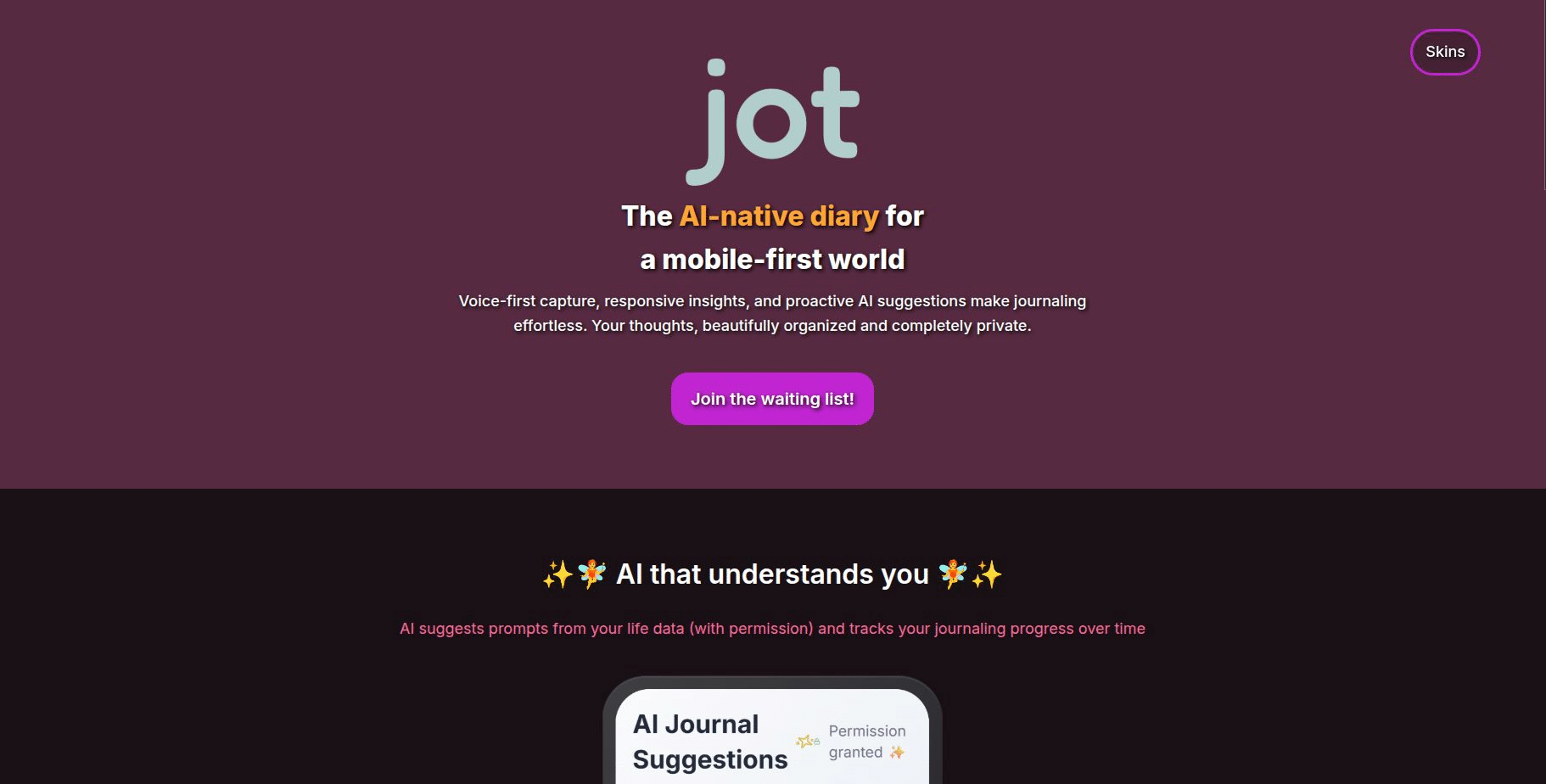
It's taken 213 years, but today we're excited to unveil Jot.
John Letts invented the original diary in 1812 thanks to the Gutenberg press. Sebastian Letts, eighth generation of the well known diary family, and Dorian Tirelli are today reinventing the diary thanks to AI. Visit Jot today and get on the hottest waiting list in town.
And mark your calendar for October...
Last week LettsSafari published one of the final sections of their comprehensive new guide to smaller-scale rewilding - it explained why LettsSafari is important to this quiet, yet developing movement:
"LettsSafari is a multi-faceted platform. First, it’s a network of rewilding parks and projects . They have on-the-ground sites where they actively practice rewilding and test models for different scales. By visiting these parks online via LettsSafari+, people can see rewilding in action - essentially living demonstrations.
Secondly, LettsSafari provides expertise and guidance distilled from 15+ years of experience. They have developed practical models for various scales - small gardens, large gardens, small parks, and more - which means if you have a particular size plot, they likely have a template or advice on how to rewild it effectively. It's like a living lab for rewilding and nature conservation at-scale.
Thirdly, LettsSafari offers a membership (LettsSafari+ and subscription) structure that makes rewilding accessible to all, even those who don’t have land to rewild themselves. For a small monthly fee (the price of a coffee, as they say), anyone can contribute to rewilding efforts - the money goes directly to creating new parks, planting trees and releasing animals."
We hope you become a member of this amazing mass-market rewilding platform - go to LettsSafari.com .
We highlight just a few startups in each monthly edition of LettsGroup's NewsFlash. To explore other companies using LettsGroup's AI VentureFactory go to LettsGroup/ventures.
LettsGroup's AI VentureFactory has been busy over the summer building routes to market, focused initially on accelerators, venture capital firms and other apps for the startup community. It already boasts a cornerstone partnership in each of these categories, to be announced soon, which should start bearing fruit this Autumn.
Last week the product team launched the VentureFactory's latest Dashboard 0.3 which offers more advanced features for both founders and investors and we believe fundamentally alters the cost of building tech and digital startups, enabling British and European startups to compete on a more even playing field with better funded US companies. Startups using the AI VentureFactory for more than 12 months have on average benefited from an 80% reduction in the cost of building their tech startup to Seed stage.
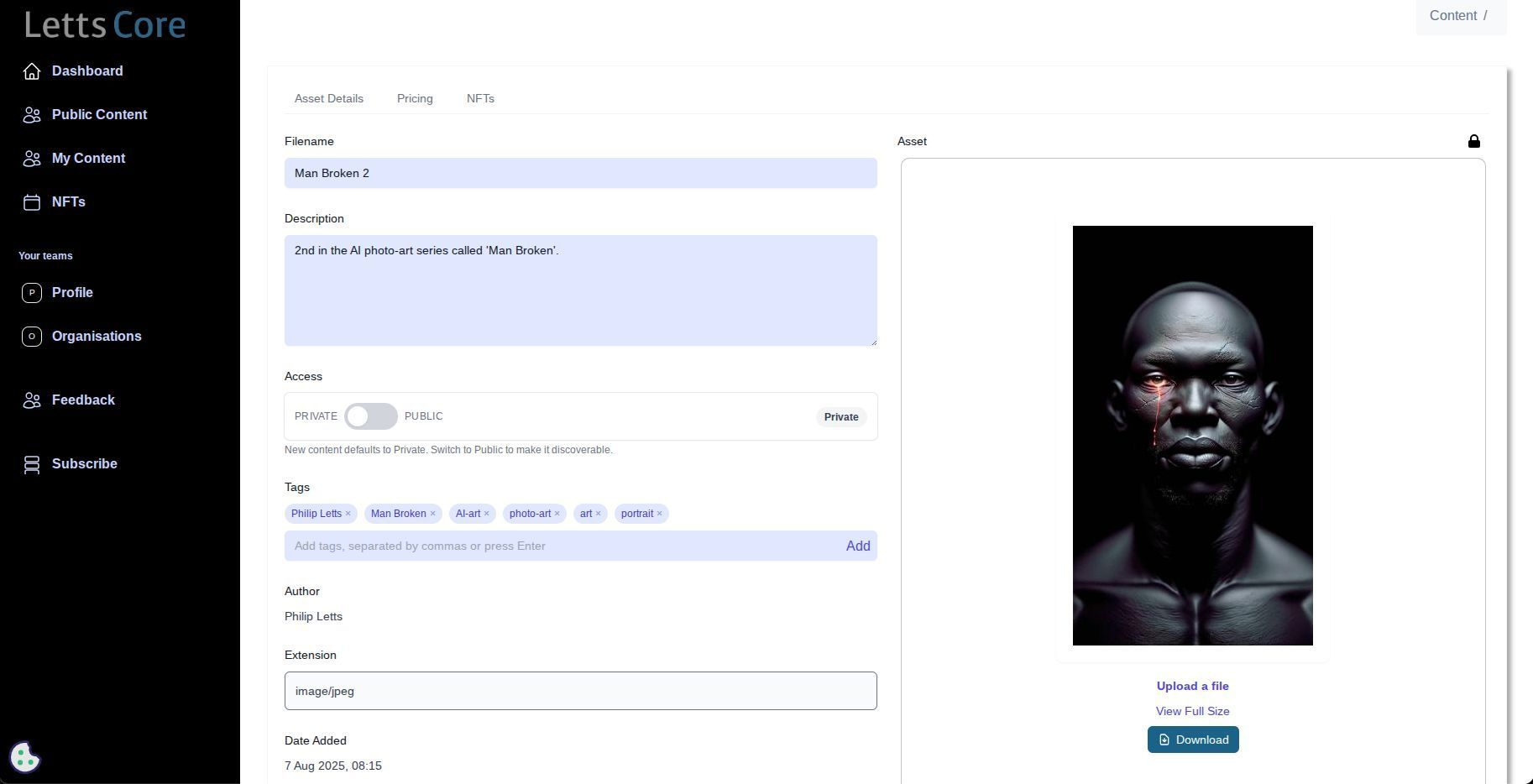
LettsCore is live in public beta and already adding more than 10 new users per week. The groundbreaking AI and Blockchain Content Management System (CMS) offers universal, distributed media storage, management and retrieval at scale, plus a series of intelligent content-enabling tools which include micro-monetisation, NFT minting, social sharing and auto-distribution. As a part of its launch offering, individual users can sign up to a free trial and get 2,000 credits . They can also set up an Organisation account. You can get going at LettsCore.com .
LettsNews was launched in public beta in late July, so in August it started to onboard early adopters. With dozens of users on board and a strong percentage upgrading to paid subscription plans, its unique place in the newsroom software market looks like it will be validated. This cost effective, AI-powered platform offers independent journalists, PR's and content managers tools normally reserved for enterprise-scale newsrooms and news publishers. The main newsroom dashboard is a web app, but the team have been busy readying their mobile apps, designed for work in the field with in-app subscription purchase, in both the Apple App Store and Google's Play Store. Coming soon.

LettsArt , the fast growing AI, no-code platform for artists, gallerists and new generation art collectors has launched LettsArt 2.5 (Phase 1) to its sizable user base. This latest release halves the time to sign up and start building an online art gallery thanks to its streamlined approach and innovative new use of AI. It also offers a next generation art management dashboard with fast, easy to use mobile capabilities and a multi-user model with advanced pricing to scale its core of independent visual artists while also starting to support professional art studios, independent gallerists and art dealers.
Jot , one of the more recent adopters of the AI VentureFactory, is readying its teaser website for imminent launch. Its young, new generation tech team pushes the bounds, using AI for practically everything. Most important, they are crafting a powerful reimagining of one of the oldest, most iconic consumer media products. It's a shoe-in for AI disruption and a category that has mass market consumer appeal with high customer usage rates. The space is competitive, but we believe that these young innovators have what it takes to deliver on their plans. They also offer a distinctly Brit brand in an overly US-polar environment. Watch this space!
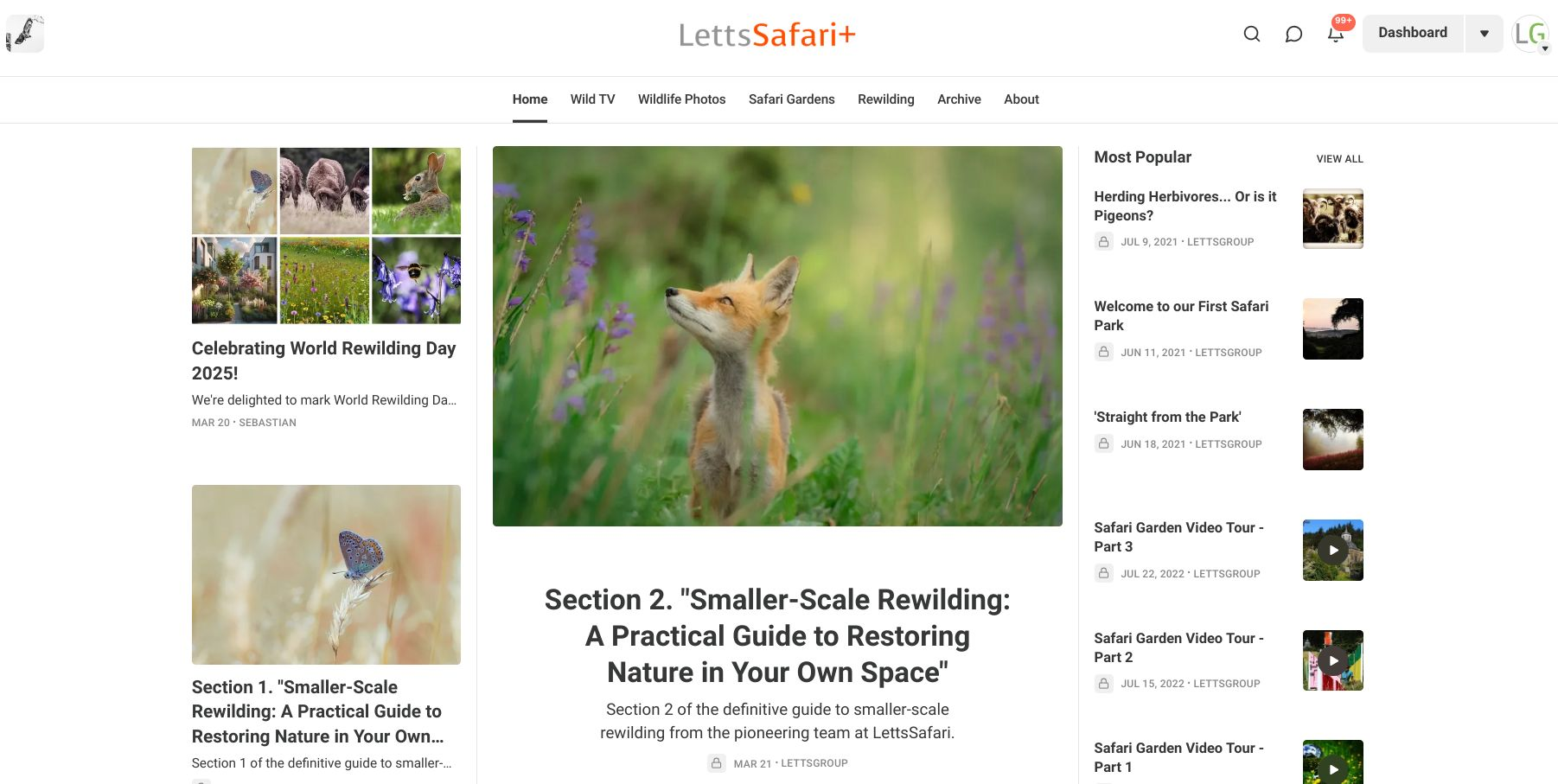
LettsSafari is a quiet, yet powerful networked movement. It makes quite a difference to its users. This long term play is perfectly suited to the AI VentureFactory, having used it the last two years to expand its digital platform while proving its smaller-scale, mass market rewilding system. To do this it needed to build and operate its digital platform arm at a systemically lower cost base to keep re-investing in its rewilding parks and its important work on the ground. The second phase of LettsSafari's journey, stepping-up to commercial scaling, involves opening national rewilding safari parks in the West as high profile commercial attractions, starting here in the UK. Demonstrating its expertise, the team has released a serialised, definitive digital guide to smaller-scale rewilding - find it here .
We highlight just a few startups in each monthly edition of LettsGroup's NewsFlash. To explore other companies using LettsGroup's AI VentureFactory go to LettsGroup/ventures.
LettsGroup's groundbreaking VentureFactory is an AI-native venture building platform that builds, scales and optimises your company at every stage. Here's how to navigate its dashboard and use the system.
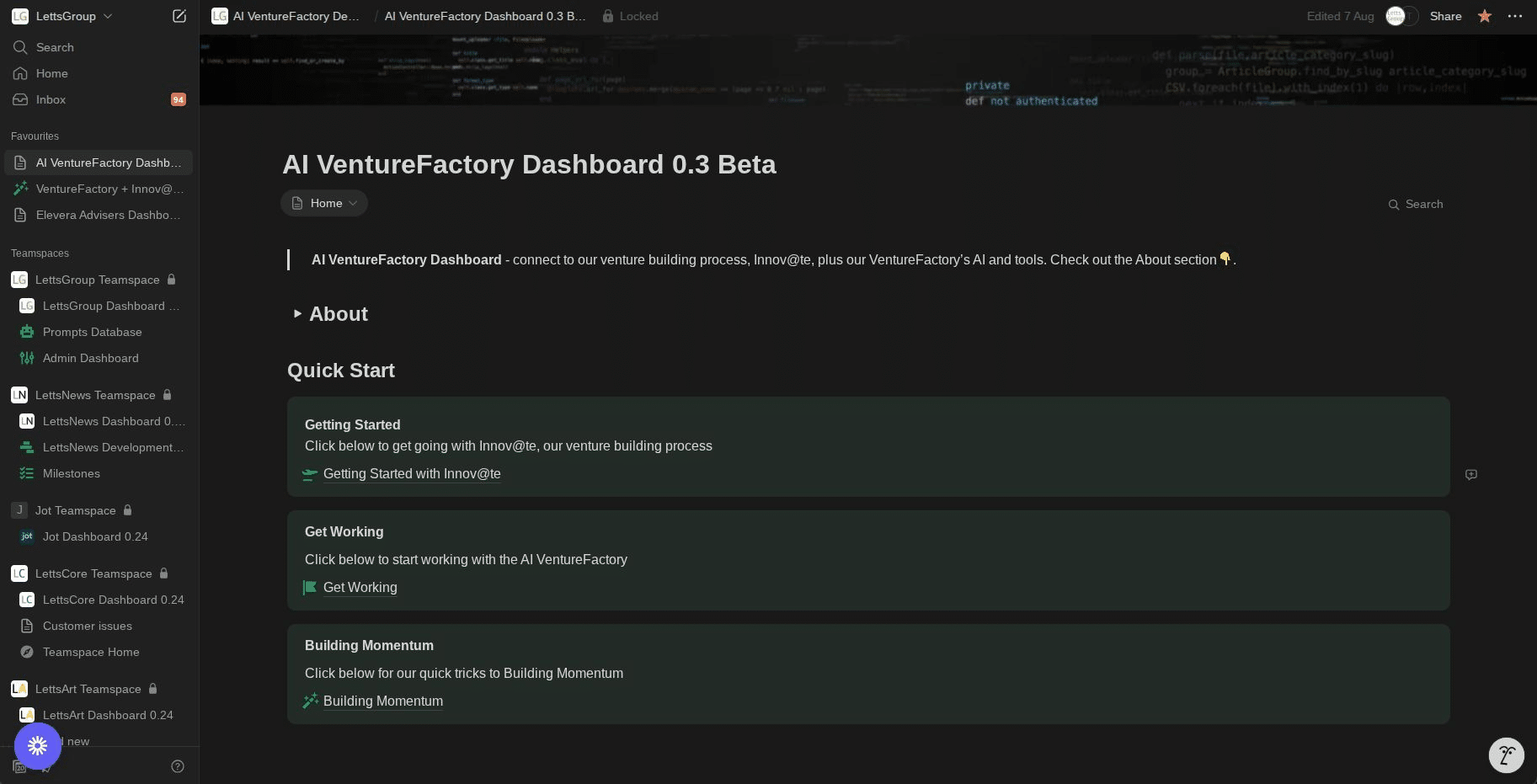
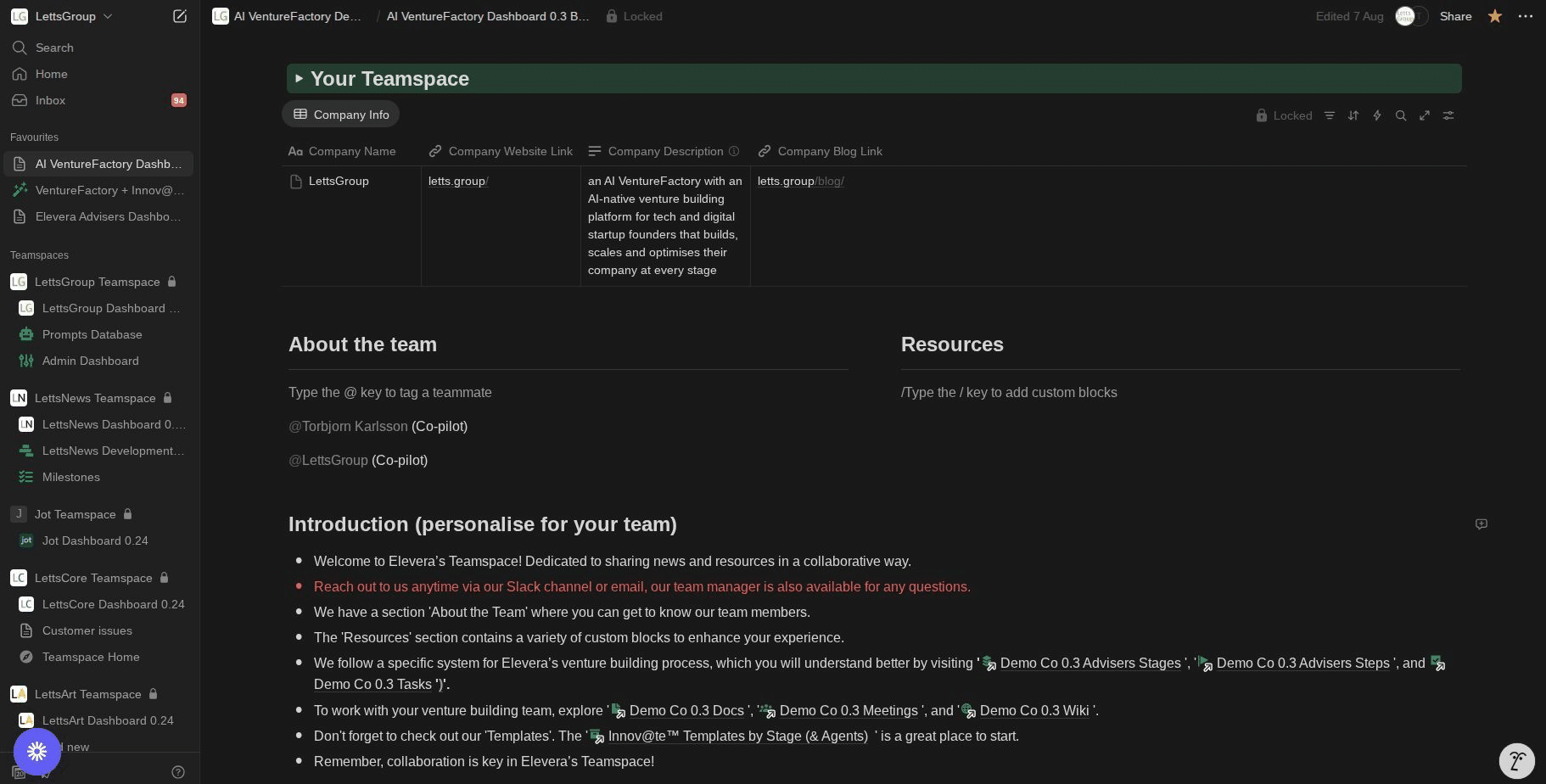
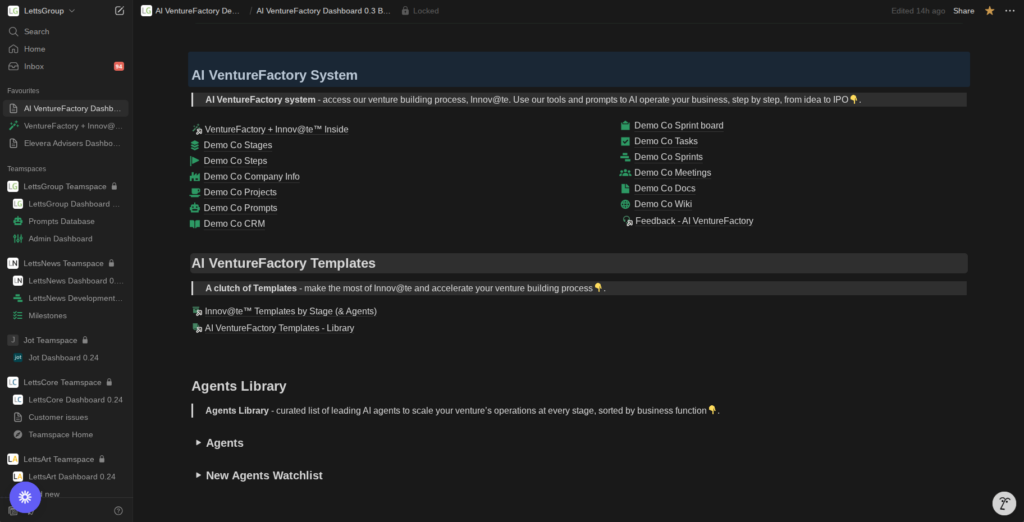
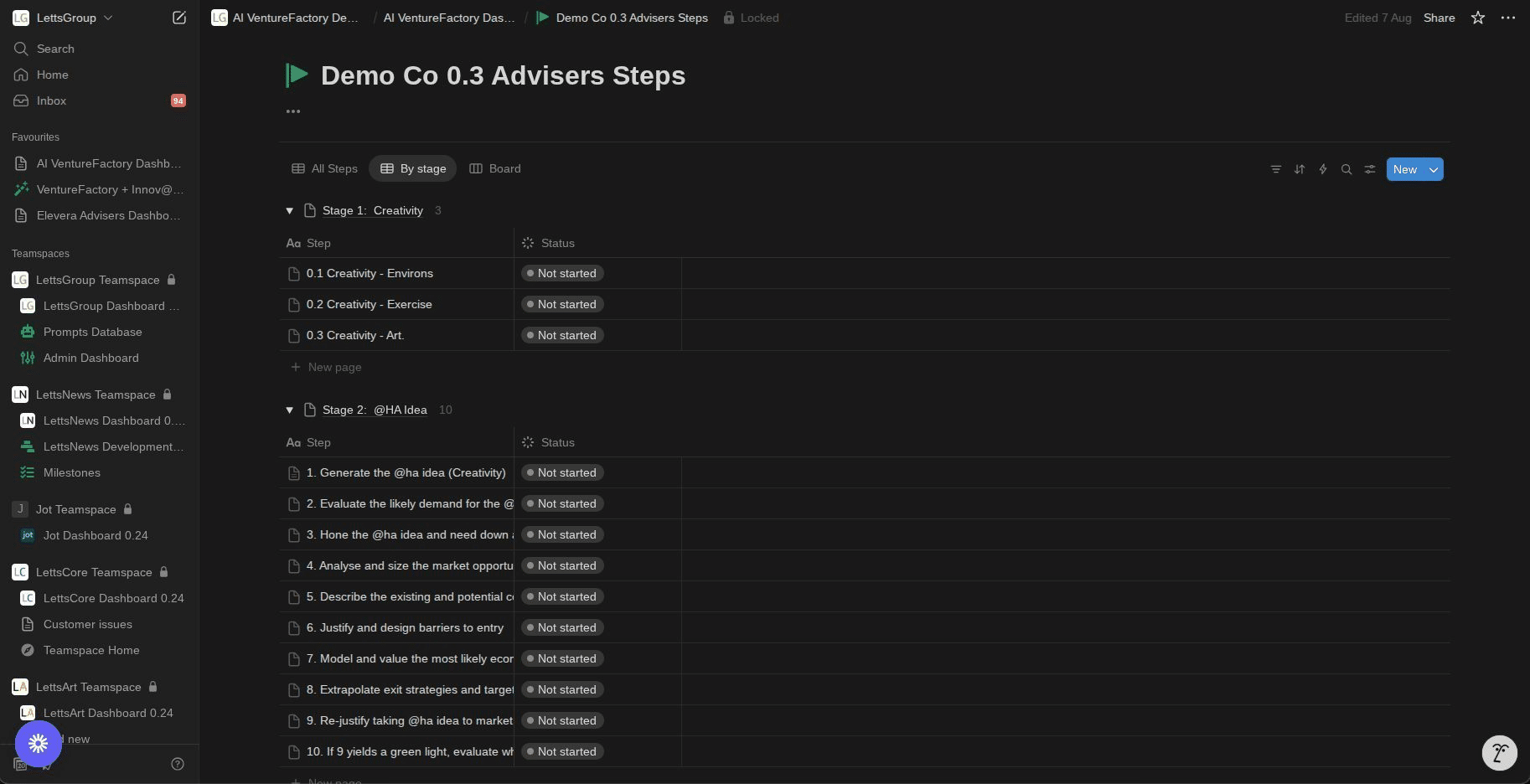
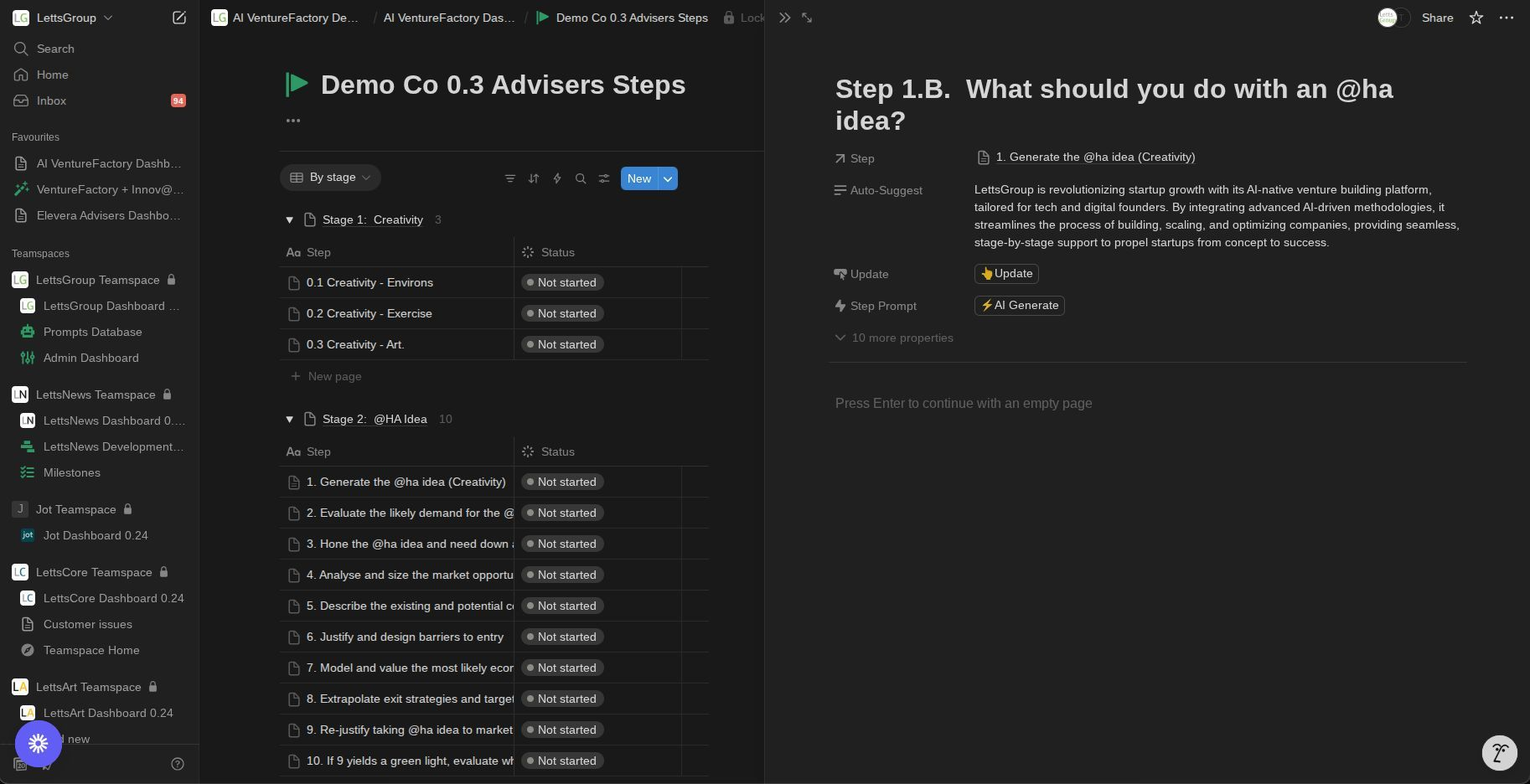
If you're a founder wanting to build your startup faster - go to www.Letts.Group today .
The media industry stands at an unprecedented inflection point as artificial intelligence transforms every aspect of content creation, distribution, and consumption. The global AI in media and entertainment market size was estimated at $25.98 billion in 2024 and is expected to reach $33.68 billion in 2025, representing a remarkable 30% year-over-year growth that signals the rapid acceleration of AI adoption across the sector.
This transformation extends far beyond simple automation, fundamentally reshaping how media organisations operate, create content, and engage audiences. In 2024, investment in generative AI businesses reached over US$56bn, as major players seek to harness its speed, scale, and creative potential, demonstrating unprecedented capital commitment to AI-driven media innovation. A recent survey by Stripe, the leading online payment processor, revealed that content generation is currently one of the biggest drivers of the AI economy, including data synthesis tools, moderating and verifying content, summarisation and insight tools, plus assistants and chatbots.
However, this revolution comes with significant challenges and implications for the workforce. At the top of the list of people most likely to have their job affected by the rise of generative AI are interpreters and translators, followed closely by historians, writers and authors, highlighting the particular vulnerability of traditional media roles.

The most significant shift in 2024-2025 has been the mainstream adoption of generative AI for content creation. In 2025, generative artificial intelligence will shift from a behind-the-scenes tool to a central driver of innovation in marketing, marking a fundamental change in how media companies approach content production.
This transformation is evident across multiple content formats:
Text and Editorial Content : AI-powered writing assistants and content generation tools have become standard in newsrooms and publishing houses. These systems can produce first drafts, generate headlines, create summaries, and even write entire articles on routine topics such as financial reports or sports scores.
Visual Content Creation : AI image generation and video synthesis tools have democratised high-quality visual content production, allowing smaller media organisations to compete with larger rivals in terms of visual appeal and production values.
Audio and Voice : AI voice synthesis and music generation have opened new possibilities for podcast production, audiobook creation, and personalised audio content at scale.
Fifty-three percent of surveyed executives say they are regularly using gen AI at work, compared with 44% of mid level managers, indicating that AI adoption is being driven from the top of organisations. This executive-level enthusiasm is translating into significant budgetary commitments, with 30% anticipating a significant increase of more than 10% in marketing budgets for 2025, much of which is being allocated to AI-powered initiatives.
The emergence of innovative platforms like LettsNews and LettsCore represents a new paradigm in media infrastructure. LettsNews is a simple, yet powerful AI-powered newsroom platform for independent journalists, PR's and content managers that enables quality "story idea to publish in minutes," demonstrating how AI is compressing traditional content creation timelines.
LettsCore is a blockchain platform redefining how content is managed, monetised and delivered. It is the first Web3 platform that lets creators control their content and reputation, maximising digital content revenue in the age of generative AI. This platform addresses critical challenges in the AI era, particularly around content attribution and monetisation.
The integration of blockchain technology with AI addresses several pressing concerns:
Content Provenance : LettsCore's blockchain and AI innovation for managing content, solves some of the biggest issues surrounding information - provenance, trust and verification. As AI-generated content becomes ubiquitous, the ability to verify authentic human-created content becomes increasingly valuable.
Creator Attribution : LettsNews is looking at adopting LettsCore to implement atom level author attribution to news pieces at considerable scale, enabling granular tracking of content creation and fair compensation for contributors.
Monetisation Innovation : Micro-monetisation built into content, enabling frictionless syndication and distribution represents a new economic model for content creators in an AI-dominated landscape.
The media industry faces significant workforce challenges as AI capabilities expand. According to the World Economic Forum's 2025 Future of Jobs report, 41% of employers worldwide intend to reduce their workforce in the next five years due to AI automation, with media organisations being particularly affected.
However, this disruption is creating new opportunities alongside job displacement. AI and automation could displace 85 million jobs by 2025, but also create 97 million new roles more aligned with the division of labour between humans, machines, and algorithms. In media, this means evolving roles that combine human creativity with AI capabilities rather than simple replacement.

LettsNews is solving the disinformation crisis. Its AI-powered news platform for high quality, democratised news, highlights how AI is being deployed not just to create content but to combat misinformation and improve information quality.
The challenge of maintaining trust while leveraging AI capabilities has become central to media strategy. There are still plenty of unresolved risks and unanswered questions that come with AI adoption: copyright litigation, accuracy issues, privacy and bias concerns, and other ethical dilemmas.
The current market landscape is characterised by intense competition for AI supremacy in media. Major technology companies are investing billions in generative AI capabilities, while traditional media companies are scrambling to integrate these technologies into their existing operations.
Technology Giants : Companies like Google, Microsoft, and OpenAI are developing foundational AI models that power media applications, positioning themselves as infrastructure providers to the industry.
Traditional Media Companies : Legacy players are adopting AI technologies for content creation, audience analytics, and operational efficiency, but face challenges in cultural adaptation and technical integration.
Emerging Platforms : Innovative companies like LettsCore are creating entirely new paradigms that combine AI, blockchain, and traditional media functions which redefine content storage, management and seamless integration with content-to-content interactions.
Media organisations are implementing AI across three primary dimensions:
Content Creation : From ideation to final production, AI tools are accelerating and enhancing creative processes.
Audience Engagement : Personalisation engines and recommendation systems are becoming more sophisticated, enabling hyper-targeted content delivery.
Business Operations : Backend processes including scheduling, resource allocation, and financial management are being automated through AI systems.
Based on current trends and technological trajectories, several key developments are likely to reshape the media industry over the next three years:
By 2026, we expect to see the emergence of "AI-native" media organisations that are built from the ground up to leverage artificial intelligence. These companies will:
Operate with radically different cost structures : Traditional media companies spend 60-70% of their budgets on human resources. AI-native organisations may operate with 20-30% human costs, allowing them to produce content at unprecedented scale and efficiency.
Deliver hyper-personalised content : Rather than broadcasting the same content to mass audiences, these organisations will create individualised content streams for each user, adjusting tone, format, and subject matter in real-time.
Implement continuous content optimisation : Using real-time feedback loops, content will be continuously refined and adapted based on audience response, engagement metrics, and emerging trends.
The traditional separation between content creation and distribution will dissolve as AI enables:
Dynamic Content Assembly : Stories will be assembled from modular components (text blocks, images, video clips, audio segments) that can be recombined for different audiences and platforms simultaneously.
Platform-Optimised Delivery : The same core content will be automatically adapted for different platforms – from long-form articles for web to short-form videos for social media – without human intervention.
Audience-Responsive Narratives : Content will adapt its structure, length, and complexity based on real-time audience feedback and engagement patterns.
By 2028, we anticipate the development of comprehensive synthetic media ecosystems where:
Virtual Personalities Drive Content : AI-generated personalities will become major media figures, hosting shows, conducting interviews, and building audiences comparable to human celebrities.
Immersive Experience Integration : The boundary between traditional media consumption and interactive experiences will blur, with audiences participating in content creation through AI-mediated interfaces.
Real-Time Event Synthesis : Major events will be covered by AI systems that can generate multiple perspectives, languages, and formats simultaneously, providing comprehensive coverage within minutes of occurrence.

The next three years will see the establishment of comprehensive regulatory frameworks addressing:
Content Attribution Standards : Mandatory disclosure of AI involvement in content creation, potentially through blockchain-based verification systems similar to LettsCore's approach.
Creator Rights Protection : New legal frameworks protecting human creators from unauthorised AI training on their work, with compensation mechanisms for licensed use.
Quality and Accuracy Standards : Industry-wide standards for AI-generated content accuracy, with liability frameworks for misinformation and errors.
Immediate Actions (2025) :
Medium-term Strategy (2026-2027) :
Long-term Positioning (2028) :
Platform Strategy : Focus on building AI-native platforms that solve specific industry pain points, similar to LettsNews's approach to democratising newsroom technology.
Technology Integration : Leverage existing AI infrastructure while developing specialised applications for media use cases, rather than attempting to build foundational AI models.
Regulatory Compliance : Build compliance and ethical AI practices into core systems from the beginning, anticipating future regulatory requirements.
Skill Development : Invest in AI literacy and learn to work collaboratively with AI systems rather than viewing them as replacement threats.
Specialisation : Focus on uniquely human skills – investigative journalism, emotional storytelling, cultural commentary – that are difficult for AI to replicate.
Platform Diversification : Utilise platforms like LettsCore that provide attribution and monetisation for human-created content in an AI-dominated landscape.
Copyright infringement is looming front and centre as the new battleground for the 21st century as these massive machine bots trawl carefree over our painstakingly created content and media. The industry must address:
As AI-generated content becomes ubiquitous, maintaining information quality and combating misinformation becomes increasingly challenging. Solutions include:
The rapid transformation of media economics will have significant social implications:
The media industry is experiencing its most significant transformation since the advent of the internet. The convergence of generative AI, blockchain technology, and new platform models is creating unprecedented opportunities for innovation while fundamentally challenging traditional business models and workforce structures.
Success in this new landscape will require organisations to balance technological adoption with human creativity, efficiency with quality, and innovation with responsibility. The companies that thrive will be those that view AI not as a replacement for human creativity but as an amplifier of human potential.
The emergence of platforms like LettsNews and LettsCore demonstrates that the future of media lies not just in adopting AI tools but in reimagining the entire content ecosystem. These platforms address critical challenges around attribution, monetisation, and trust that will become increasingly important as AI-generated content becomes mainstream.
LettsNews users can write once and distribute to multiple different places, including their blog, at the push of a button, doing what used to take many hours in just a few minutes. This efficiency gain, multiplied across the entire media ecosystem, represents a fundamental shift in how information is created, distributed, and consumed.
The next three years will be critical in determining whether this transformation leads to a more diverse, accessible, and creative media landscape or one dominated by a few AI-powered giants. The choices made by media organisations, policymakers, and technology developers today will shape the information ecosystem for decades to come.
Organisations that start their AI transformation now, with careful attention to ethical considerations and workforce development, will be best positioned to thrive in the AI-native media landscape of 2028. Those that delay risk being left behind by competitors who have successfully integrated AI into their core operations and value propositions.
The revolution is already underway. The question is not whether AI will transform media, but how quickly and effectively organisations can adapt to harness its potential while preserving the human elements that make media compelling, trustworthy, and valuable to society.
This analysis is based on current market data, industry trends, and emerging platform developments as of August 2025. The predictions and recommendations should be regularly updated as the rapidly evolving AI landscape continues to develop.
To implement an AI-driven, automation-first approach, startups need to assemble a tech stack and toolset that can handle as much of the work as possible with minimal human intervention. Essentially, you’re building a “startup operating platform.” Let’s break down the essential tools and systems that enable scalable venture building, often used in combination as part of platforms like LettsGroup’s AI VentureFactory :
Centralised Venture Management Platform: At the core, it’s important to have a single platform or dashboard where you can manage the venture’s process . This includes tracking the venture’s progress through stages (as per a methodology like Innov@te) and keeping all team tasks and data in one place. For example, the AI VentureFactory itself serves this role - it provides a structured approach to venture building, guiding the team on what to do next. Even if not using that specific product, a startup can set up an equivalent by integrating project management (like Jira or Trello), documentation (like Notion or Confluence), and communication (Slack, etc.) and enforcing their use for all tasks. The key is visibility and structure : everyone knows the current goals, tasks, and status. Modern platforms often have AI features to summarise project status or remind the team of overlooked tasks.
Integrated Software Apps Suite: A scalable venture should avoid a patchwork of disconnected tools. Instead, use an integrated suite for core functions . LettsGroup’s platform, for instance, bundles apps for marketing automation, CRM, productivity, project management, tasks, issue tracking, investor management and more. A startup might achieve a similar setup by choosing a main hub (say, an enterprise SaaS like Zoho One, or a combination of Slack + Monday + HubSpot + etc. that are connected). The rationale is that when these systems talk to each other, you can automate workflows between them. For example, when a new lead comes in via a web form (marketing system), it automatically creates a deal entry in the CRM and alerts someone on Slack. Or when developers push new code (tracked in issue tracker), it updates the project timeline. Seamless data flow between functions means less manual handoff and fewer things falling through cracks. It also enables unified analytics (seeing the whole funnel from marketing to sales to support).

AI and Automation Tools: This is the special sauce. You want AI tools embedded in various parts of your operations:
Modern venture building platforms like LettsGroup's AI VentureFactory integrate a suite of software apps (marketing, CRM, project management, etc.) along with a library of leading AI tools and templates. This provides startups with an out-of-the-box tech stack where every essential function is ready to be automated and scaled.
Venture Resource Planning (VRP) System: Borrowing the analogy from ERP in large companies, a startup should implement its own version of an integrated resource planning system early. This means having a clear handle on resources - not just financial, but human resources, timelines, and milestones. Tools like Asana or Monday can serve as lightweight ERP for startups when configured well. LettsGroup's AI VentureFactory essentially acts as a full-scale VRP, coordinating all aspects of the venture. The benefit is that founders can see, for example, how a delay in product feature X might impact the marketing launch, or how hiring one more engineer might speed up a timeline – all in one place. It treats the venture holistically.

Scalable Infrastructure (Cloud and DevOps): On the technical side, using a cloud infrastructure that can scale on demand is foundational. This avoids the scenario where your product becomes a hit but the servers crash under load. Platforms like AWS, Azure, or Google Cloud with auto-scaling and managed services ensure you can handle growth without needing a big IT team. Coupled with this, DevOps automation (CI/CD pipelines, infrastructure as code) means new software releases and infrastructure changes can be rolled out rapidly and repeatedly. Many startups fail to implement good DevOps early and suffer when their engineering velocity slows or a deployment goes wrong at scale. A venture builder will set up things like automated testing, continuous integration, and one-click deployment from the start, so the tech backbone is solid. This also ties into security - automated security scans, backups, and monitoring should be in place to protect the venture as it grows (a breach or major outage can be fatal to a young company).
Data Analytics and Feedback Systems: A key to scaling is listening to data. Implement analytics in your product (e.g., Mixpanel, Google Analytics, custom dashboards) to track user behaviour and business metrics. Then use AI to interpret that data. For example, AI can segment users and find patterns (“users who do X are 30% more likely to convert to paid”). Having a good data pipeline (even something simple like daily reports) that is set from the beginning means by the time you have lots of users, you already have historical data and insights. Newer AI analytics tools can even automatically run experiments or optimisations - for instance, an AI pricing tool that adjusts your prices based on demand to maximise revenue.
Collaboration and Knowledge Management: As the team grows (even if it’s from 3 to 10), having a centralised knowledge base is important so that information scales and isn’t lost. Tools like a wiki or even an AI Q&A bot trained on your company’s docs can be invaluable. LettsGroup incorporated a wiki-style system with AI into its platform to ensure knowledge is organised and accessible. This means when a new team member joins, or when an investor asks for documentation, everything is there. It also means less reliance on any one person’s memory.
Investor & Stakeholder Management Tools: If the venture will interface with investors, having a system to manage investor updates, cap tables, and due diligence documents is helpful. There are tools that automate the creation of update reports (pulling metrics into a nice template) and manage the cap table for you (e.g., Carta). These reduce the headache of financing so founders can focus on the business. The venture factory approach typically ensures startups are “funding-ready” at each stage by prepping these materials systematically. Even if not raising money, having your key metrics and board materials always up-to-date is good discipline and saves scrambling later.
In essence, the toolkit for an automation-first startup spans every function of the business . A useful way to think of it is: list out all the roles a large company would have (engineer, product manager, sales rep, marketer, finance, HR, customer support, etc.) and then pick a tool or process that covers each of those roles in a minimal way initially. Many of those “roles” can be partly filled by AI or software in an early startup. For example:
The goal is minimal human overhead, maximal output. Each tool should ideally reduce the need to add a person. When the time does come to add team members, they step into a structured environment where tools handle repetitive tasks and they can focus on higher-level contributions.
A potential pitfall is tool overload - it’s easy to adopt a ton of SaaS tools and create complexity. That’s why integration and centralisation are stressed. It’s better to have a cohesive framework (even if composed of multiple tools) than dozens of disconnected apps. This is why something like LettsGroup’s all-in-one platform is attractive: it provides a curated stack that already works together. But even without that, a startup should invest time in selecting tools that play well together and setting them up properly. Consider using open APIs and webhooks to connect any tools that aren’t natively integrated.
Security and privacy considerations also come with using many tools and AI services. Startups need to ensure they protect customer data when using third-party AI APIs, for example, and that they comply with regulations (like GDPR) even when automating processes. Automation doesn’t remove the need for oversight; it changes the type of oversight needed (from supervising people to auditing systems). So establishing good data governance early is wise.
To summarise, the essential stack for scalable venture building includes:
By putting this toolkit in place, even a very small team can project the capabilities of a much larger organisation. The mantra is: Automate early, automate often. Every hour saved by automation is an hour that can be spent on strategy, customers or innovation - the things humans do best. This tool-enabled efficiency is exactly how a startup with 5 people can compete with a company of 50. It’s the engine that powers the new style of venture building. With the right systems, a startup essentially gains “digital employees” in the form of AI and software routines, which work 24/7, don’t make mistakes (if set up correctly), and scale effortlessly.
Equipping a startup with these tools is arguably now as important as hiring the right people. In fact, part of “hiring” in the future might be “hiring” AI services - choosing which AI will handle your customer support or your code reviews, for example. Entrepreneurs and investors should view a solid automation tech stack not as a luxury but as core infrastructure for success in modern venture building. Those who leverage it will have a strong advantage in cost and agility over those who don’t.
The next section of our guide to 'New Style Venture Building' is 'Implications for Venture Capital' - coming soon.
If you're a tech or digital startup founder, build faster and better with LettsGroup's AI VentureFactory .
Last month LettsGroup's AI VentureFactory, launched to external startup founders and investors. Already gaining traction with new startups subscribing, the team is developing channels with VC's, accelerators and other startup focussed apps. In late June, the VentureFactory's new 'Investor' plan launched - providing previously unattainable investor intelligence with a unique mirror 'pit' of portfolio or prospect companies. This month, the team has been extending the platform's innovation agent with more advanced AI models for one-click plans, strategies, tools and stage by stage deliverables tailored to the business.

LettsNews launched in public beta last week. The next-generation newsroom platform is designed to enhance the future of independent media - it offers freelance journalists, independent content creators, and small media teams a powerful suite of AI-powered publishing, distribution and promotional tools. It delivers leading newsroom tech for the our information environment:
Users can sign up for free, and upgrade to more advanced plans at LettsNews.com .

LettsArt is rolling out LettsArt 2.5 (Phase 1) to its growing user base in the coming days. It includes:
Following the initial Phase 1 roll-out, LettsArt 2.5 is extending further to include additional social features and auto-distribution of digital art to leading 3rd party online art marketplaces. The team is excited to bring the benefits of LettsArt 2.5 to the 1,100 galleries and 3,500 users that rely on its AI no-code software for the art world.
LettsCore will be fully live in public beta in August. The three year deeptech R&D project is delivering a groundbreaking new AI and blockchain content management system that gives creators and content-rich companies total control over ownership, monetisation and intelligent distribution. It turns every piece of content into an autonomous asset. Beyond this, it is an exciting, next generation content operating system that's built to scale globally with lower compute costs, while transforming content at the atomic level into intelligent, secure, revenue generating assets. With its successful private beta LettsCore will, post launch, already have thousands of users on its platform.
Find out more at LettsCore.com .
LettsSafari is busy extending its community capabilities and reach, and planning a series of social campaigns designed to give it a wider reach in the UK and abroad. This UK based, mass market rewilding platform has nearly completed the first phase of its build, offering a network of private rewilding safari parks which use its pioneering smaller-scale rewilding system, blended with a unique digital, subscription based mediatech model. With phase 1 soon completed, the team will start work on the next phase of its development, planning to build and operate national safari parks, starting in the UK, that are fully open to the public. With its next phase of growth, LettsSafari's rewilding platform can make a considerable, system-level impact on nature restoration and conservation in the UK and abroad.
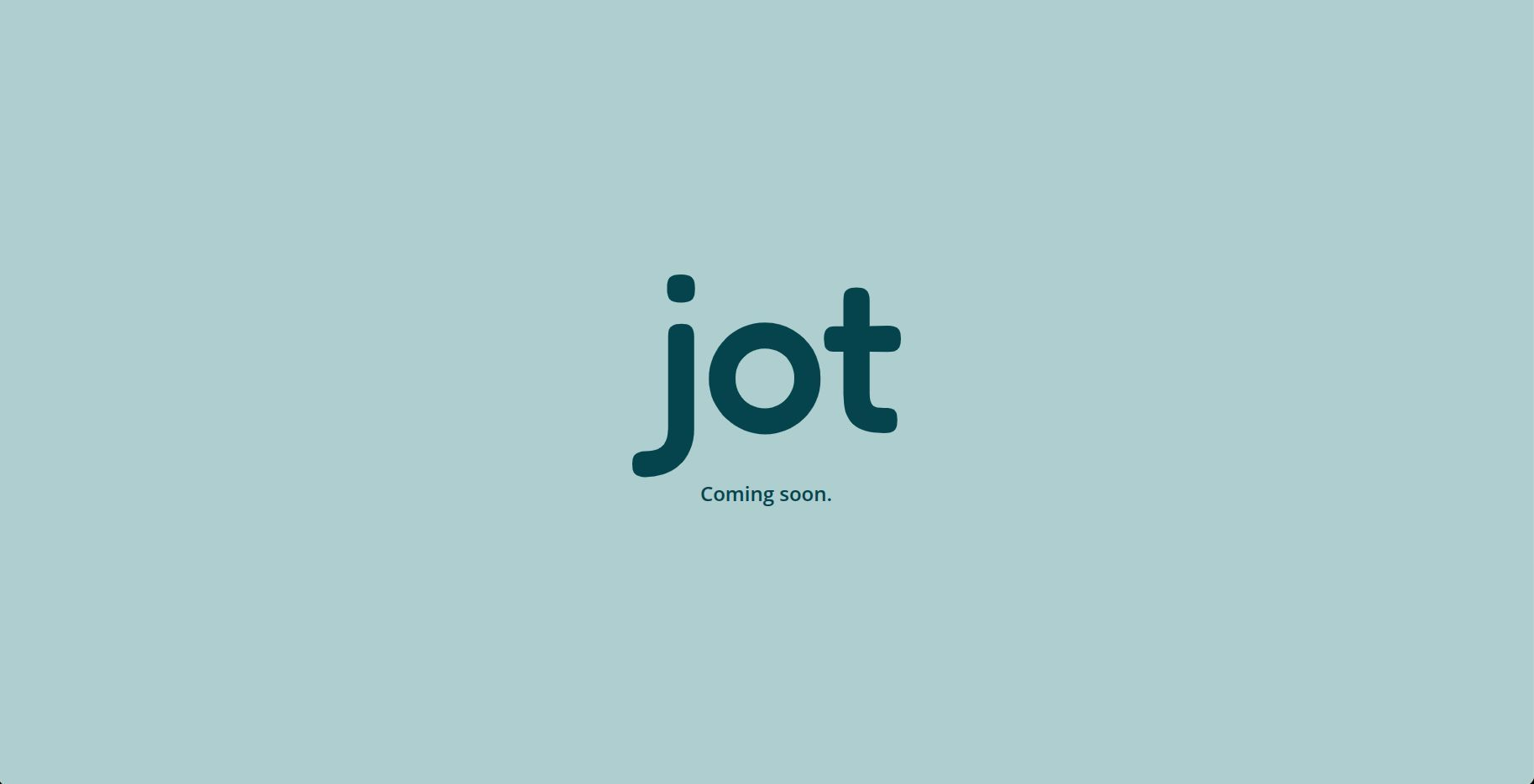
We are excited that Jot has adopted LettsGroup's AI VentureFactory, aiming to become one of the first startups to build 100% with AI. The new consumer tech startup is going after a sizable category with an innovative AI-native offering. The VentureFactory provides Jot with full-scale AI venture building, while its team is using AI heavily to build its product and tech. They are also working on an innovative go-to-market launch campaign that is both AI designed and created. They will use LettsNews for AI-powered news/story generation and distribution.
We highlight just a few ventures in each monthly edition of LettsGroup's NewsFlash. To explore other companies using LettsGroup's AI VentureFactory go to LettsGroup/ventures.